Flickr, the photo/video sharing site, has had its ups and downs since Yahoo bought it 10 years ago. Its purpose, design, and features have changed several times, not always to popular acclaim.
But one thing is for sure: Flickr’s 112 million account holders are in for a big surprise this week with the new Flickr 4.0.
I’m going to describe the seven major new features, but I have to be very, very careful doing it. I work for Yahoo, so it’d be silly for me toreview a Yahoo product.
All I can do is describe Flickr. But assess it? Don’t ask me. I’m absurdly biased.
New feature No. 1: Universal 1-terabyte autobackup
Flickr’s design is mostly unchanged, and no features are going away.You still get 1 terabyte of free storage for your photos and videos — that’s around 500,000 photos, or enough for your first child’s first three birthday parties.
(Not to make any kind of judgment here, but a mathematician might note that Flickr therefore gives you 67 times as much free space as Microsoft OneDrive, 200 times as much free storage as Apple’s iCloud, and 500 times as much as Photobucket.com or Dropbox. By the way, Google Photos also offers an auto-uploading program for your computer—but it’s limited to 15 gigabytes on the free plan.)
You can still post your photos, tag, name, edit, slideshow, and organize them; order printed stuff; search the photos of the other 99,999,999 members; and discuss them (the photos, not the members).
But despite the terabyte of storage, Flickr was never much good as a backup system. You had to manually upload every new batch of photos. If disaster struck, and your computer died, you could restore your precious full-resolution photos — by downloading them one at a time. Lovely.
And that was a real shame. Because if you asked 100 people what one item they’d rush into their burning homes to rescue, most would say, “My pictures and videos.” I’d be willing to bet that as you read this very sentence, you don’t have a complete, totally current backup of every picture and video on your phone, tablet, and computer(s).
Handshake bet, anyway.
The new Flickr changes all of that. There’s now a free little program for Mac or Windows called Uploadr. All it does is sit in the background and watch for pictures and videos that enter your ecosystem: when you connect a hard drive, insert a flash drive, introduce a camera’s memory card, grab a photo from a website, take as a screenshot, or save from an email attachment.
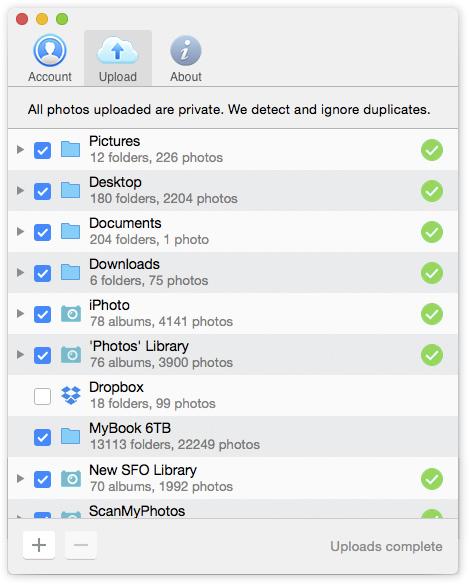
And also, of course, your existing photo collections: photos in folders, photos in iPhoto or Aperture, photos in your Dropbox. Even I was startled when I connected an external drive to my laptop last week and got this message:
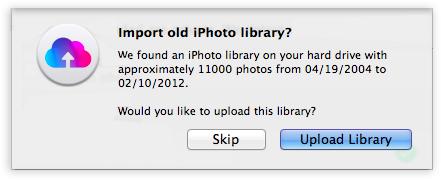
The big idea, of course, is to consolidate all your pictures — your entire life’s worth — in a single place online, where it’s safe and easily searchable. (Alas, the uploader doesn’t yet auto-upload the photos in Adobe Lightroom.)
This, by the way, is also the idea behind Apple’s new iCloud Photo Library. But that’s not free like Flickr; Apple charges you $240 a year for that terabyte. And Apple’s service works only with iPhones, iPads, and Macs; Flickr’s works with Mac, Windows, Android, and iOS.
It took a whole week for Uploadr to finish uploading all 92,000 of my pictures — from a motley assortment of backup drives, old iPhoto libraries, flash drives, and even old DVDs. I just let my computer sit there, day and night, uploading every scattered photo I’ve ever taken. But now I know that everything is backed up online.
(Yes, 92,000. Yes, I’m what you call an avid photographer. Yes, I love my kids.)
The Uploadr automatically filters out duplicate photos. It also marks everything it uploads as private. Only you can see them. That way, Flickr hopes, your scantily clad photos won’t accidentally become the next viral sensation.
Of course, at any point, you can make certain photos public, or limit their viewing to people on special lists, like Friends or Family.
New feature No. 2: New phone apps
There are new Flickr apps for iPhone and Android today, too. They look and work the same as Flickr.com; they, too, offer auto-uploading of every picture and video.
If you can come to trust the uploading procedure, an intriguing possibility presents itself: You can delete photos and videos from your phone after they’re backed up. Your life of living with the hassle of a nearly full phone is over.
Yet you can still view and work with your pictures in the Flickr phone app, even though they’re no longer physically on the phone.

And by the way: Since there are Flickr apps for Apple TV, Roku, TiVo, and so on, the following scenario is now possible: You go to a concert or something. By the time you get home, the photos you’ve taken with your phone are already on Flickr — and you can pull them up on the TV to show your roommates or family.
New feature No. 3: Redownloading
Once your pictures are on Flickr, you can select any batch of them (by dragging through them or clicking Select All for a full day’s batch) and then click a Download button that appears beneath:
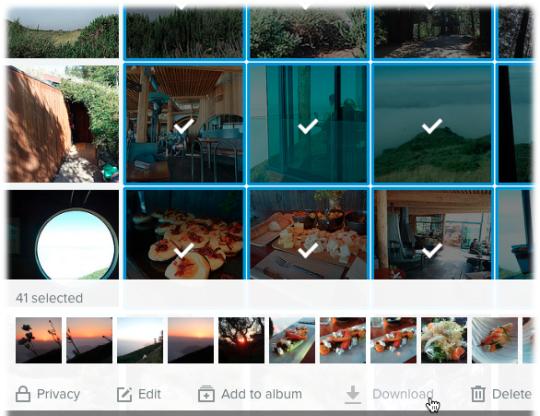
At this point, Flickr delivers the original, full-resolution photos back to you, compressed into a .zip file to make the process faster.
On Flickr, you can organize your pictures into Albums, which are virtual containers; a single photo can appear in lots of different Albums. You can’t yet download an Album with one click, but that feature will arrive shortly.
New feature No. 4: Universal Camera Roll
In the new Flickr, you still have your Photostream (all photos that you’ve made public). But now you also have a Camera Roll (all your pictures, public and private). Making its debut in the Camera Roll: a timeline ruler, which lets you jump to any month or year without having to scroll.
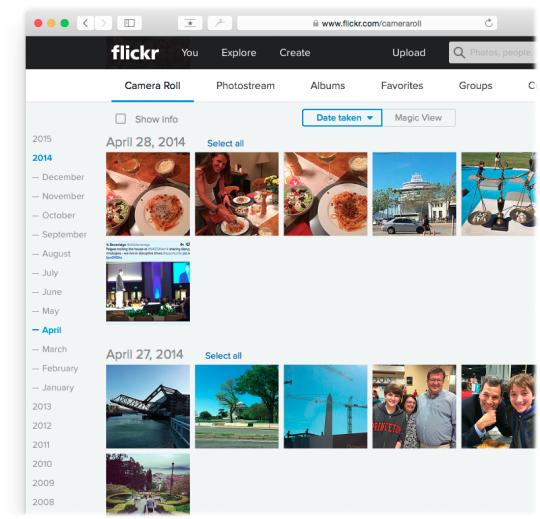
In the Camera Roll, moreover, you can sort your pictures either by date taken or date uploaded.
New feature No. 5: Instant Share button
Once you’ve organized some pictures or videos into an album, you might conceivably want to share it — with a friend, with Facebook or Twitter, and so on. A new Share button produces a private link to that album:
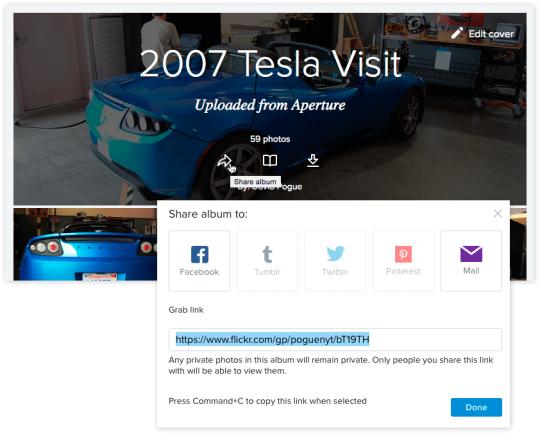
Only people who have that Web address can see the pictures.
New feature No. 6: Image recognition groupings
It’s finally come to pass: Computers can look at a photo and know what it’s a picture of.
Thanks to Yahoo’s 2013 acquisition of two artificial-intelligence image-recognition software companies, Flickr now knows what you’ve taken pictures of.
You don’t have to name your pictures, tag them, keyword them, or whatever. Flickr knows that that’s a picture of a beach, a wedding, a banana, a portrait — by looking at it.
Google Photos has had photo recognition already, for searching purposes. But Flickr also offers a button called Magic View. It presents a collapsible left-side list of photographic subjects present in your photos, under headings like Animal, Architecture, Food, Landscape, and People. Click Bird to see all your bird pictures:

Click Wedding to see all your wedding pictures:
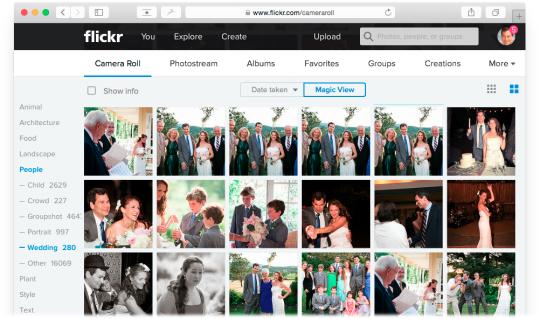
Click Music to see all pictures of people making music:
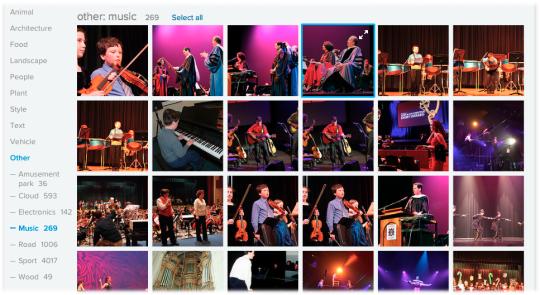
Or Writing, or Sport, or Shore, or even stylistic terms like Pattern, Black-and-white, Abstract, Serene, or Depth of Field… Flickr recognizes 1700 kinds of subjects and styles so far.
I won’t say that my jaw hit the floor when I saw this feature. Because that would be a conflict of interest.
But I would if I could.
New feature No. 7: Image recognition in search
The new Search box lets you use the same image-recognition technology to search all 11 billion photos on Flickr at once (or at least those that have been made public).
Searching for “pumpkin pie” no longer finds photos of pumpkins and pies; it finds pictures of pumpkin pies.
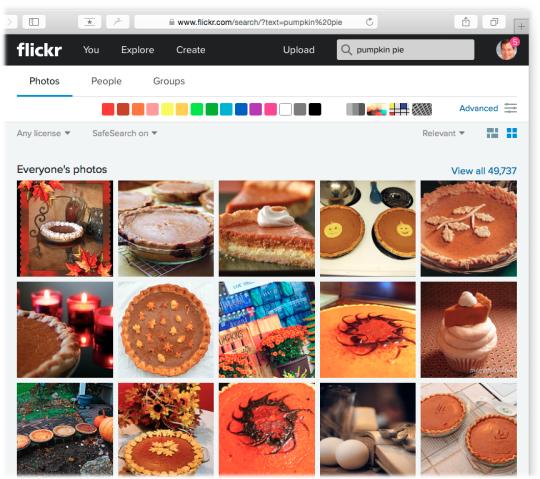
And once you’ve done a search, you can filter down the results according to what colors prevail in the photos. Here’s my search for motorcycles —
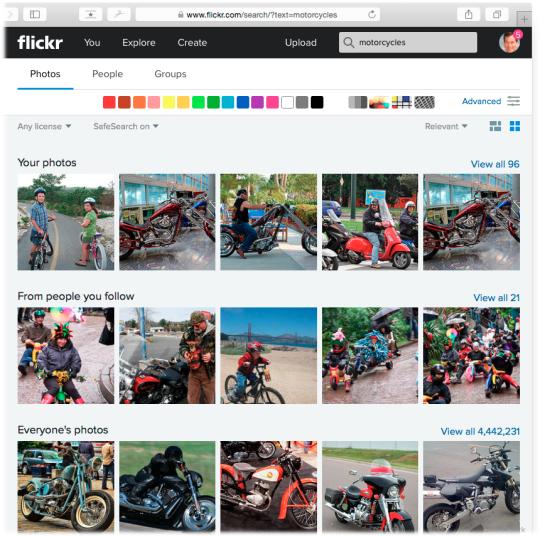
— and here’s when I turn on the Blue and Yellow checkboxes:
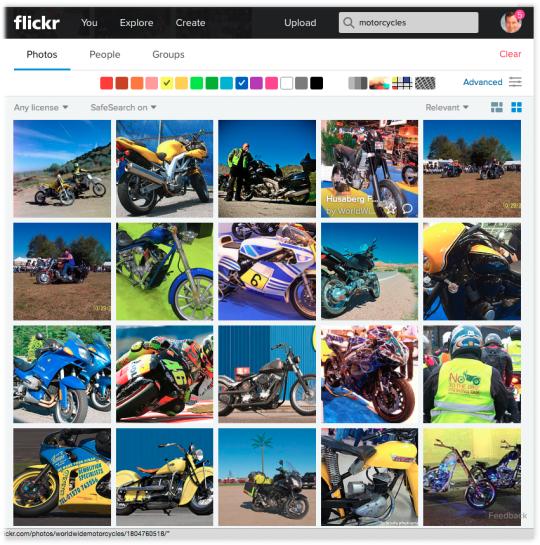
I can then use the License pop-up menu to choose “Commercial use allowed” or “No known copyright restrictions,” and boom: I’ve just found royalty-free photos of the subject and color scheme I want — and given migraines to the stock-photo companies.

The Search box now understands places, holidays, months, and years, too. So if you remember that amazing dog you saw last Halloween in Tulsa, you can search for “dog halloween tulsa,” and Flickr will find it.
Next steps
I’m not allowed to tell you how excited I am to finally, finally, have all my photos from all my gadgets in one centralized place, instantly searchable and sortable, and accessible from my phone. I can’t mention the deep sense of psychological satisfaction that comes from knowing that the most important files of my entire existence are safe.
It’s probably fine for me, though, to tell you what still needs work. As amazing as the new stuff is, many of the older parts of Flickr still need a visit from the Makeover Fairy.
Here’s what I think should be on Flickr’s to-do list:
- The Batch Organize screen (called the Organizr) is just as cluttered and nonintuitive as it was when George W. Bush was president.
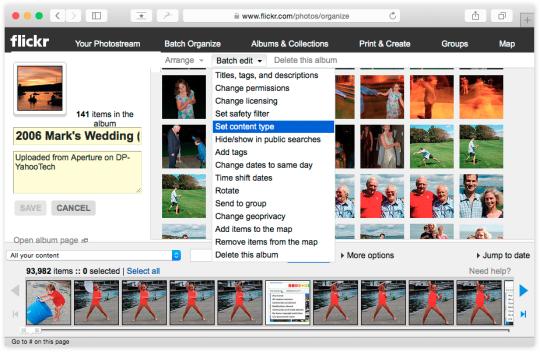
The Batch Organize screen.
- The new Camera Roll feels fluid and slick, especially when it comes to selecting photos. Click to select (or deselect), drag across to select a batch, double-click to open. But the Photostream and album screens use totally different conventions for selecting and opening. (Flickr says they’ll soon be made to match.)
- There’s no facial recognition by name yet—Flickr doesn’t know your subjects by name. (That, too, is on the way.)
- The uploader doesn’t recognize what’s in Adobe Lightroom.
- You can’t delete pictures right from an album. You have to go into the dreaded Organizr to do it.
- Flickr is starting to get Menu Creep. There are two menu bars — and the lower one disappears when you’re in an album or when you click Create, and there’s no obvious way to get it back again.
Now then. If this were a traditional review, this is where you’d find the whole package summarized and evaluated. But I’m not allowed to do that.
All I can do is state the facts, coldly and clinically. For example, Flickr gives you 1 terabyte of storage for your photos and videos, for free; automatically backs up all your photos and videos, past and future, from all your computers, phones, and tablets, for free; permits access to those pictures and videos from your phone; permits instant redownloads of any group of pictures at original resolution; offers one-click sharing of albums by generating a custom Web address; and lets you search or group your photos according to what they’re pictures of.
Does that make Flickr an amazing deal, with eye-popping photographic intelligence and a mature set of truly useful features?
I’m afraid you’ll have to answer that question yourself.

No comments:
Post a Comment